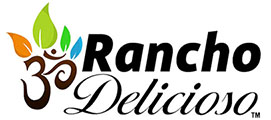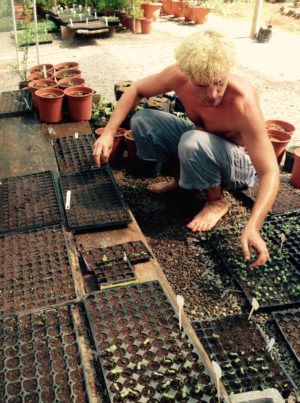Permaculture at Rancho Delicioso
Clement is a passionate Permaculturist, with an upbeat sense of humor, who decided to stay at Rancho Delicioso with Jacquelyn to be in charge and manage the volunteer program. It’s a love story deeply rooted for both of them, as they both enjoy nature, yoga and people.
With the various field specific interests of the volunteers, they are re-designing the farm according to the principals of permaculture. Within just a few months they have beautifully revolutionized the landscape of the farm. Next year Jacquelyn and Clement would like to start workshops where you will be able to learn about permaculture and Yoga. Clement will facilitate the permaculture introduction which will progress onto a Permaculture Design Course Certificate later in the year. Whilst Jacquelyn encourages reflection of true self through yoga and meditation.
We have been working very hard here at Rancho Delicioso lately. Since the rainy season, we have been making many efforts to reclaim the land and prepare for a bounty of new crops! One of the main jobs that’s been taking place at the farm is the construction of new beds.
This may sound simple, but it requires much more than creating piles of dirt. Proper bed-making is a craft. If you want your crops to do well, you must make sure their environment is feeding them well.
The first method that we practiced was using banana tree stalks to fill our beds. With so many banana trees surrounding the farm, we thought we might as well put the stalks to good use. Strategically placing them under the soil provides the bed with moisture, carbon and many other vital nutrients. We also added layers of other materials to these new beds to create a “lasagna” of sorts. Rice husks, hay from the chicken coop that we remove weekly, cow manure, charcoal and banana peels lay on top of one another- each separated by a layer of dirt. Once everything was stacked, one final layer of fresh hay was laid as mulch.
The reason for so much work being put into this project is that raised beds provide plant roots with optimal growing conditions. They will more easily penetrate the soil and have greater depth available in which to grow. Between the size and the makeup of our new beds, the crops planted here are bound to be exceptionally healthy.
In the case of the photos below, we discovered a new soil-enrichment technique through a happy accident. We found that one of the tilapia ponds has a leak, which was running into surrounding garden beds. The soil here is nearly 100% clay, which is typically difficult to grow in, but it turns out that the nutrients from our tilapia ponds are a great aid to our beds. In fact, the crops in these areas thrive more than any other! So rather than fix the leak, we are taking advantage of it by growing plants that need a lot of water all day and night. In a way, this is a hybrid aquaponics form of growing.
This is just the beginning- as we continue to build our greenhouses and transplant new fruits and veggies, we will surely adopt other creative methods to fuel them. Stay tuned for future progress of the beds here at the farm!



















